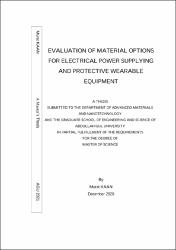| dc.contributor.author | KAAN, Murat | |
| dc.date.accessioned | 2021-12-18T08:41:23Z | |
| dc.date.available | 2021-12-18T08:41:23Z | |
| dc.date.issued | 2020 | en_US |
| dc.date.submitted | 2020-12 | |
| dc.identifier.uri | https://hdl.handle.net/20.500.12573/1089 | |
| dc.description.abstract | Ballistic vests used in military applications are usually made out of layers of various materials and then combined to form a solitary conservative vest. Contrasted with bygone eras, functionality and productivity of ballistic vests have improved to a critical sum. ANSYS was explicitly used to compute such finite element analysis and the initial segment of the postulation dealt with the determination of material used for the first/front layer of the vest. Since nowadays all ballistic vests almost use Kevlar and epoxy layers in the material formation of the vest, the similar material candidates were chosen for this research as well. Practically, the only choice of material that had to be decided is for the front layer of the vest since many different materials can be used in that regard. Silicon Carbide (SiC) was picked on the grounds that it demonstrated the least deformation and least stress compared to other materials that were tested in ANSYS. In total; three materials were tested and evaluated respectively were Silicon Carbide, Boron Carbide (BC) and Alumina (Al2O3). In order to prove the protection of the ballistic vest design and its reliability in the ballistic sense, 6 (six) flawless shots were fired at certain points on the vest, based on American NIJ standards. In short, the thesis examines the protection of ballistic protective vests from serious military injuries during combat and the development of a hybrid solution that will provide the vest with a new function to provide the power needs of the equipment the soldier will need during combat. In addition, a novel idea is proposed to the literature by adding the fourth layer into the FEA based examined ballistic vest. | en_US |
| dc.language.iso | eng | en_US |
| dc.publisher | Abdullah Gül Üniversitesi, Fen Bilimleri Enstitüsü | en_US |
| dc.rights | info:eu-repo/semantics/openAccess | en_US |
| dc.subject | Ballistic Vest | en_US |
| dc.subject | Ballistic Resistance | en_US |
| dc.subject | Composite | en_US |
| dc.subject | Perforation | en_US |
| dc.subject | Lithium Battery | en_US |
| dc.title | EVALUATION OF MATERIAL OPTIONS FOR ELECTRICAL POWER SUPPLYING AND PROTECTIVE WEARABLE EQUIPMENT | en_US |
| dc.type | masterThesis | en_US |
| dc.contributor.department | AGÜ, Fen Bilimleri Enstitüsü, İleri Malzemeler ve Nanoteknoloji Ana Bilim Dalı | en_US |
| dc.relation.publicationcategory | Tez | en_US |


















